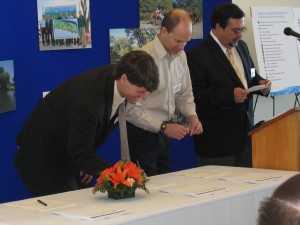
American Whitewater Signs Oroville Settlement Agreement
Culminating a five year effort, American Whitewater signed the settlement agreement for the Oroville Project on the Feather River in California. This Settlement Agreement amongst 50 State and Federal Agencies, local governments, tribes, and non- government organizations will provide an array of recreational and environmental benefits to the area in and around the project. Dave Steindorf, California Stewardship Director for American Whitewater, speaking about the agreement said, � Whitewater Paddlers and all river recreationist should be pleased and surprised what we have achieved in this relicensing�. �We are also proud of the fact this is the third Settlement Agreement that American Whitewater has signed in the Feather Basin and that we are the only Non-Government Organization that has participated in all of the Project Relicensing on the Feather River.� As the primary source of water for the State Water Project and the tallest dam in the United States, the relicensing of the huge Oroville facilities have been a massive undertaking. All four forks of the Feather River drain into Lake Oroville, which inundated over sixty miles of river when it was constructed in the 1960�s. Providing for river recreation opportunities on a project that most people just associate with its 3,000,000-acre foot reservoir has not been easy. In the six years of this relicensing proceeding American Whitewater has been working on educating the Department of Water Resources (DWR) and other stakeholders, to the need to provide for river recreation as part of this project. Some of the recreational and environmental highlights of the agreement include:
A $250,000 study to investigate the feasibility of developing a whitewater park on the Oroville project.
- Develop a shuttle service to provide access to the North Fork's Big Bend run and Middle Fork's Bald Rock Canyon run that empty into the lake.
- Develop a river trail along the Lower Feather.
- Improve flows in the class I/II Lower Feather low flow channel.
- Better access for flat-water paddling opportunities.
- A $15 million Salmon Habitat Restoration mitigation fund.
One of the important points according to Steindorf is that access to the Bald Rock Canyon run on the Middle Fork Feather was protected and improved via this Agreement. "Most Class V paddlers in the West were unaware that they were about to have severely restricted access to what is arguably the crown jewel of California whitewater, Bald Rock Canyon", said Steindorf. The private access that people have been using for years recently sold and the new owners are not interested in continuing to allow public to use their land as a take-out. The shuttle service that was negotiated by American Whitewater for the Middle Fork and the Big Bend run on the North Fork will protect access for these runs for the next forty years.
Another highlight of this agreement is the feasibility study for the development of a whitewater park. The best whitewater park designers in the country have been drooling at the many possibilities for developing a whitewater facility on the Oroville project. No less than five sites have been identified as possible locations for park. "The potential here is incredible" according to Steindorf, with flows that could range from 600 to 6000 cfs and course lengths that could exceed a mile in length. The Feasibility Study will commence this year and be finished in 2007. The agreement also provides $50 million to a fund that will be used to develop a number of projects in the Oroville area. Once the study is complete we will have a better idea of the cost of this project and then we can peruse an array of funding sources to make this project a reality.
Lastly, but maybe most important of all, American Whitewater working closely with American Rivers who helped to craft a separate agreement with the DWR and PG&E to fund a $15 million effort to restore habitat for Anadromous Fish in the Sacramento Basin. The Feather River was once home to some of the largest salmon runs in California. The many dams on the Feather have had substantial impact on the spawning and rearing of fall run and even more importantly spring run Chinook and Steelhead. Rather than approaching this problem with the traditional solutions of dam removal or cumbersome truck and haul programs, American Rivers and American Whitewater crafted a proposal to find a better way to recover these endangered species. By seeking out the highest yield opportunities this agreement seeks to focus our resources on the areas of the region that are most likely to have real success in improving the numbers of these endangered fish.
Read the entire Settlement Agreement on the FERC website.
